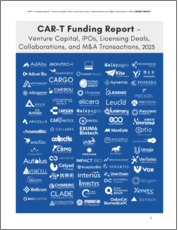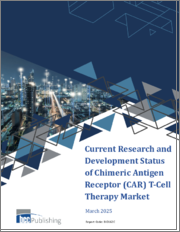
|
시장보고서
상품코드
1729045
급성 림프성 백혈병용 CAR T 세포치료 시장 - 세계 및 지역별 분석 : 유래 유형별, 표적 유형별, 지역별 - 분석과 예측(2025-2035년)CAR T-Cell Therapy for Acute Lymphoblastic Leukemia Market - A Global and Regional Analysis: Focus on Source Type, Target Type, and Region - Analysis and Forecast, 2025-2035 |
||||||
세계 급성 림프성 백혈병용 CAR T 세포치료제 시장은 현재 수명주기의 성장 단계에 있습니다.
Kymriah와 같은 선구적인 치료제가 승인되고 재발성 난치성 ALL 치료에 효과가 입증됨에 따라 시장은 크게 확산되고 있습니다. 이 단계의 특징은 임상적 증거의 확대, 환자 접근성 증가, 연구개발에 대한 투자 확대입니다. 또한 규제 당국의 승인과 새로운 치료법 시장 진입으로 인해 업계는 더욱 확대되고 있습니다. 그러나 높은 치료 비용, 제조의 복잡성, 장기적인 안전성 데이터의 필요성 등의 과제는 여전히 남아있습니다. 이러한 장애물에도 불구하고 치료법 혁신, 전략적 파트너십, 차세대 CAR T세포 치료제의 지속적인 개발로 시장은 강력한 성장세를 보이고 있습니다.
영향력
- 급성 림프성 백혈병 치료를 위한 CAR T 세포 치료에 대한 수요 증가는 예측 기간인 2025-2035년 동안 시장 성장을 지원할 것으로 예측됩니다.
- 세계 급성 림프성 백혈병 CAR T세포 치료제 시장은 진단 기술의 발전, 혁신적인 치료법 시장 개발, 환자 및 의료진의 인식 제고로 인해 큰 성장이 예상됩니다.
북미는 첨단화된 의료 인프라, 높은 유병률, 질병에 대한 인식이 높아짐에 따라 예측 기간 중 세계 급성 림프구성 백혈병 CAR T 세포 치료제 시장을 장악할 것으로 예측됩니다. 또한 이 지역은 규제적 이점과 강력한 제약회사의 존재로 인해 효과적인 치료법의 활용을 촉진하고 세계 급성 림프성 백혈병 CAR T 세포 치료제 시장의 성장을 주도하고 있습니다.
최근 동향
- 규제 활동: 2025년 3월, FDA는 소아 및 성인 재발성/불응성 T-ALL/LBL 환자를 대상으로 한 CTD402의 IND 신청을 승인하고, 단일군 비맹검 1b/2상 임상시험을 개시했습니다.
- 규제 당국의 활동2024년 11월, FDA는 Autolus Therapeutics의 CAR-T 세포 치료제 AUCATZYL에 대해 성인 r/r형 B-ALL 환자의 치료제로 판매 허가를 부여했습니다.
수요 - 촉진요인과 한계
급성 림프성 백혈병에 대한 세계 CAR T 세포 치료제 시장 성장 촉진요인은 다음과 같습니다.
- 급성 림프성 백혈병의 유병률 상승
- 제조 및 공정 개선의 발전
- 지역별로 승인된 탄탄한 제품 파이프라인을 보유하고 있습니다.
세계 급성 림프성 백혈병 CAR T 세포 치료제 시장은 다음과 같은 과제들로 인해 몇 가지 제약에 직면할 것으로 예상됩니다.
- 높은 치료비
제품/혁신 전략: 세계 급성 림프성 백혈병 CAR T 세포 치료제 시장의 제품 출시와 혁신은 환자 치료를 개선하기 위한 치료 옵션의 발전에 초점을 맞추었습니다. 이러한 혁신은 치료 효과를 높이고 질병 발견과 관리를 간소화하기 위한 것으로, Autolus Therapeutics를 비롯한 주요 시장 진출기업은 급성 림프성 백혈병에 대한 CAR T 세포 치료제를 개발하기 위해 노력해 왔습니다.
경쟁 전략: 세계 급성 림프성 백혈병 CAR T 세포 치료제 시장의 선두 기업은 경쟁력을 유지하기 위해 혁신적인 치료법으로 제품 포트폴리오를 지속적으로 업데이트하고 있습니다. 이 보고서는 급성 림프성 백혈병 CAR T 세포 치료제 세계 시장에서 주요 기업에 대한 상세한 경쟁 벤치마킹을 실시하여 제품 제공, 시장 점유율, 기술 혁신 측면에서 이들 기업이 어떻게 비교되고 있는지에 대한 경쟁적 인사이트을 제공합니다. 이 벤치마킹을 통해 독자들은 시장 상황과 주요 기업의 포지셔닝를 명확하게 이해할 수 있습니다. 또한 파트너십, 계약, 제휴 등 종합적인 경쟁 전략은 독자들이 시장에서 미개발 매출 기회를 파악하는 데 도움이 될 것입니다.
주요 시장 진출기업 및 경쟁사 요약
기업 개요은 1차 전문가로부터 수집한 정보를 바탕으로 기업 커버리지, 제품 포트폴리오, 시장 침투도를 분석하여 선정합니다.
주요 기업에는 급성 림프성 백혈병 CAR T 세포 치료제 공급업체가 포함되며, 전 세계 급성 림프성 백혈병 CAR T 세포 치료제 시장의 약 95%를 점유하고 있습니다.
세계의 급성 림프성 백혈병용 CAR T 세포치료 시장에 대해 조사했으며, 시장의 개요와 유래 유형별, 표적 유형별, 지역별 동향 및 시장에 참여하는 기업의 개요 등을 제공하고 있습니다.
목차
개요
조사 범위
제1장 세계의 급성 림프성 백혈병 CAR-T 세포치료 시장 : 시장 전망
- 업계 전망
- 시장 역학
제2장 세계의 급성 림프성 백혈병 CAR-T 세포치료 시장(유래 유형별, 100만 달러, 2023-2035년)
- 자가 이식
- 동종이계
제3장 세계의 급성 림프성 백혈병 CAR-T 세포치료 시장, 표적 유형별, 100만 달러, 2023-2035년
- CD-19
- CD-22
- 기타
제4장 세계의 급성 림프성 백혈병 CAR-T 세포치료 시장, 지역별, 100만 달러, 2023-2035년
- 북미
- 유럽
- 아시아태평양
제5장 세계의 급성 림프성 백혈병 CAR-T 세포치료 시장 - 경쟁 벤치마킹과 기업 개요
- 경쟁 구도
- 각사의 주요 전략과 개발
- 주요 발전 분석
- 기업 개요
- Novartis AG
- Autolus Therapeutics
- Gilead Sciences
- OneChain Immunotherapeutics
- Cellectis S.A.
- Wugen, Inc.
- Bioheng Therapeutics
제6장 조사 방법
KSA 25.06.09Market Lifecycle Stage
The global CAR T-cell therapy for acute lymphoblastic leukemia market is currently in the growth stage of its lifecycle. Following the approval of pioneering therapies such as Kymriah and the successful demonstration of their efficacy in treating relapsed and refractory ALL, the market has seen a significant increase in adoption. This stage is characterized by expanding clinical evidence, increasing patient access, and growing investment in research and development. Furthermore, with regulatory approvals and new therapies entering the market, the industry is poised for further expansion. However, challenges such as high treatment costs, manufacturing complexities, and the need for long-term safety data remain. Despite these obstacles, the market is experiencing robust growth driven by innovations in therapy, strategic partnerships, and the ongoing development of next-generation CAR T-cell therapies.
Impact
- Increasing demand for CAR T-cell therapy for acute lymphoblastic leukemia therapies is anticipated to support the growth of the global CAR T-cell therapy for acute lymphoblastic leukemia market during the forecast period 2025-2035.
- The global CAR T-cell therapy for acute lymphoblastic leukemia market is expected to grow at a significant rate due to advancements in diagnostic technologies, the development of innovative therapies, and increasing awareness among patients and healthcare providers.
Market Segmentation:
Segmentation 1: by Source Type
- Autologous
- Allogeneic
Segmentation 2: by Target Type
- CD19
- CD22
- Others
Segmentation 3: by Region
- North America
- Europe
- Asia-Pacific
- Rest-of-the-World
North America is expected to dominate the global CAR T-cell therapy for acute lymphoblastic leukemia market during the forecast period due to its advanced healthcare infrastructure, high prevalence of disease, and increased awareness of the disease. The region also benefits from regulatory advantages and a strong pharmaceutical presence, which accelerates the availability of effective treatments and drives the growth of the global CAR T-cell therapy for acute lymphoblastic leukemia market.
Recent Developments:
- Regulatory Activities: In March 2025, the FDA approved the IND application for CTD402 for treating pediatric and adult patients with relapsed/refractory T-ALL/LBL, which enabled the commencement of a single-arm, open-label phase 1b/2 trial.
- Regulatory Activities: In November 2024, the FDA granted marketing approval for Autolus Therapeutics' CAR-T cell therapy, AUCATZYL, for the treatment of adult patients with r/r B-ALL.
Demand - Drivers and Limitations
The following are the drivers for the global CAR T-cell therapy for acute lymphoblastic leukemia market:
- Rising Prevalence of Acute Lymphoblastic Leukemia
- Advancements in Manufacturing and Process Improvements
- Robust Product Pipeline with Regulatory Approvals Across Geographies
The global CAR T-cell therapy for acute lymphoblastic leukemia market is expected to face some limitations too, due to the following challenges:
- High Treatment Costs
How Can This Report Add Value to an Organization?
Product/Innovation Strategy: Product launches and innovations in the global CAR T-cell therapy for acute lymphoblastic leukemia market are focused on advancing treatment options to improve patient care. These innovations aim to enhance the efficacy of therapies and streamline the detection and management of the disease. Key players in the market, such as Autolus Therapeutics, have been involved in the development of therapies for CAR T-cell therapy for acute lymphoblastic leukemia.
Competitive Strategy: Enterprises led by market leaders in the global CAR T-cell therapy for acute lymphoblastic leukemia market are continuously working on updating their product portfolios with innovative treatments to maintain competitiveness. A detailed competitive benchmarking of the key players in the global CAR T-cell therapy for acute lymphoblastic leukemia market has been conducted, providing insights into how these companies compare in terms of product offerings, market share, and innovation. This benchmarking provides readers with a clear understanding of the market landscape and the positions of the leading players. Additionally, comprehensive competitive strategies, such as partnerships, agreements, and collaborations, will help readers identify untapped revenue opportunities in the market.
Key Market Players and Competition Synopsis
The companies that are profiled have been selected based on inputs gathered from primary experts and by analyzing company coverage, product portfolio, and market penetration.
The top segment players include CAR T-cell therapy for acute lymphoblastic leukemia therapy providers that capture around 95% of the global CAR T-cell therapy for acute lymphoblastic leukemia market.
Some of the prominent names established in this market are:
- Autolus Therapeutics
- Bioheng Therapeutics
- Cellectis S.A.
- Gilead Sciences
- Novartis AG
- Wugen, Inc.
- OneChain Immunotherapeutics
Table of Contents
Executive Summary
Scope of Study
1. Global CAR T-Cell Therapy for Acute Lymphoblastic Leukemia Market: Market Outlook
- 1.1 Industry Outlook
- 1.1.1 Market Overview and Ecosystem
- 1.1.2 Key Trends
- 1.1.3 Epidemiological Analysis of Acute Lymphoblastic Leukemia
- 1.1.3.1 By Region
- 1.1.4 Clinical Trials
- 1.1.4.1 By Phase
- 1.1.4.2 By Sponsor Type
- 1.1.5 Regulatory Landscape / Compliance
- 1.1.5.1 Legal Requirement and Framework in the U.S.
- 1.1.5.2 Legal Requirement and Framework in the E.U.
- 1.1.5.3 Legal Requirement and Framework in Japan
- 1.1.5.4 Legal Requirement and Framework in Rest-of-the-World
- 1.2 Market Dynamics
- 1.2.1 Impact Analysis
- 1.2.2 Market Drivers
- 1.2.3 Market Restraints
- 1.2.4 Market Opportunities
2. Global CAR T-Cell Therapy for Acute Lymphoblastic Leukemia Market, By Source Type, $Million, 2023-2035
- 2.1 Autologous
- 2.2 Allogeneic
3. Global CAR T-Cell Therapy for Acute Lymphoblastic Leukemia Market, By Target Type, $Million, 2023-2035
- 3.1 CD-19
- 3.2 CD-22
- 3.3 Others
4. Global CAR T-Cell Therapy for Acute Lymphoblastic Leukemia Market, By Region, $Million, 2023-2035
- 4.1 North America
- 4.1.1 Key Findings
- 4.1.2 Market Dynamics
- 4.1.3 Market Sizing and Forecast
- 4.1.3.1 U.S. CAR T-Cell Therapy for Acute Lymphoblastic Leukemia Market (by Country)
- 4.1.3.1.1 U.S.
- 4.1.3.1 U.S. CAR T-Cell Therapy for Acute Lymphoblastic Leukemia Market (by Country)
- 4.2 Europe
- 4.2.1 Key Findings
- 4.2.2 Market Dynamics
- 4.2.3 Market Sizing and Forecast
- 4.2.3.1 Europe CAR T-Cell Therapy for Acute Lymphoblastic Leukemia Market (by Country)
- 4.2.3.2 U.K.
- 4.2.3.3 Germany
- 4.2.3.4 France
- 4.2.3.5 Italy
- 4.3 Asia-Pacific
- 4.3.1 Key Findings
- 4.3.2 Market Dynamics
- 4.3.3 Market Sizing and Forecast
- 4.3.3.1 Asia-Pacific CAR T-Cell Therapy for Acute Lymphoblastic Leukemia Market (by Country)
- 4.3.3.2 China
- 4.3.3.3 Japan
5. Global CAR T-Cell Therapy for Acute Lymphoblastic Leukemia Market - Competitive Benchmarking and Company Profiles
- 5.1 Competitive Landscape
- 5.1.1 Key Strategies and Developments by Company
- 5.1.1.1 Funding Activities
- 5.1.1.2 Mergers and Acquisitions
- 5.1.1.3 Regulatory Approvals
- 5.1.1.4 Partnerships, Collaborations and Business Expansions
- 5.1.2 Key Developments Analysis
- 5.1.1 Key Strategies and Developments by Company
- 5.2 Company Profiles
- 5.2.1 Novartis AG
- 5.2.1.1 Company Overview
- 5.2.1.2 Product Portfolio
- 5.2.1.3 Target Customers/End Users
- 5.2.1.4 Analyst View
- 5.2.2 Autolus Therapeutics
- 5.2.2.1 Company Overview
- 5.2.2.2 Product Portfolio
- 5.2.2.3 Target Customers/End Users
- 5.2.2.4 Analyst View
- 5.2.3 Gilead Sciences
- 5.2.3.1 Company Overview
- 5.2.3.2 Product Portfolio
- 5.2.3.3 Target Customers/End Users
- 5.2.3.4 Analyst View
- 5.2.4 OneChain Immunotherapeutics
- 5.2.4.1 Company Overview
- 5.2.4.2 Product Portfolio
- 5.2.4.3 Target Customers/End Users
- 5.2.4.4 Analyst View
- 5.2.5 Cellectis S.A.
- 5.2.5.1 Company Overview
- 5.2.5.2 Product Portfolio
- 5.2.5.3 Target Customers/End Users
- 5.2.5.4 Analyst View
- 5.2.6 Wugen, Inc.
- 5.2.6.1 Company Overview
- 5.2.6.2 Product Portfolio
- 5.2.6.3 Target Customers/End Users
- 5.2.6.4 Analyst View
- 5.2.7 Bioheng Therapeutics
- 5.2.7.1 Company Overview
- 5.2.7.2 Product Portfolio
- 5.2.7.3 Target Customers/End Users
- 5.2.7.4 Analyst View
- 5.2.1 Novartis AG



















